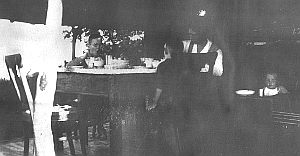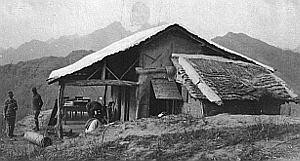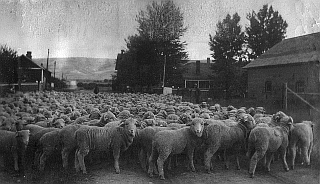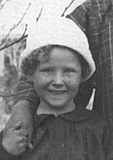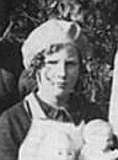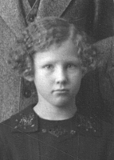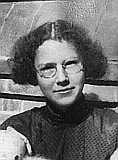
|
|
“And here’s the birthday party—had to honor the
birthday parties... This is my mother’s handwriting now”
on the image back. From top right:
Mrs. Clack, Douglass Clack, Edith Galt, Marjorie Hubbard, Ralph Galt,
Constance, Harold, Bertran (sp?) Hubbard, Gordon Clack, Table Boy
(in door window). “Table Boy is the Chinese servant that waited
on table... These [people] lived in Paotingfu.”
—EARR, Growing Up In China (GUiC),
Part I, March 1999
|
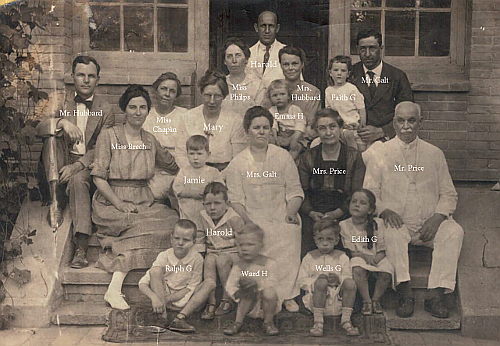
|
|
Robinsons and other American Board members in Paotingfu, circa 1922
“This is a little bit later than this birthday party, because
there’s little Jim, and the Hubbards now have moved into the
Hubbard’s house.... This is Grace Breck, I think. This is
Isabel Philps. She loved me a lot and I wasn’t yet born, but
when I had scarlet fever and was incarcerated in the third floor of
our house and my mother had to stay with me and nurse me—it must
have been terrible—and Harold wasn’t allowed to come
back from Tuchow (his boarding school) that Christmas vacation (and
he didn't like that), and Jim stayed downstairs with my father ...
So this is the kind of community I grew up in. And there were
always kids, but there were not as many—this is more kids
than I remember because by the time I came along the Hubbards were
living in that house.... And Mr. Hubbard, he was just wonderful ...
he was a minister. There is a book out called The Call
[by John Hersey, 1985] that’s really about him [and five others],
it’s a novel.”
—EARR, Growing Up In China (GUiC),
Part II, March 1999
|
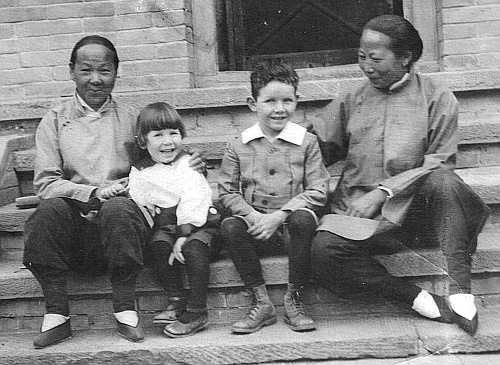
|
|
“Here are some bound feet. These are my two brothers’
Amahs. My Mother could go and teach english—she loved to
teach Walt Whitman, she loved Chinese poetry and she loved American
poetry.... She could write, better than my father could. She was the
literary person and it comes down [into Mary’s descendants]. This is
Jim’s Amah, and I think she was called, Wang Nai Nai
[Looking at the back of the picture, is the text:]
‘Amah and Sewing Woman with two Robinson boys’. This
is Wang Nai Nai and maybe this was our Sewing Woman
but it looks like she’s Harold’s Amah, too.... And I
think this may be the steps—not our front steps—but the
steps out of my father’s study door....
—EARR, Growing Up In China (GUiC),
Part II, March 1999
|
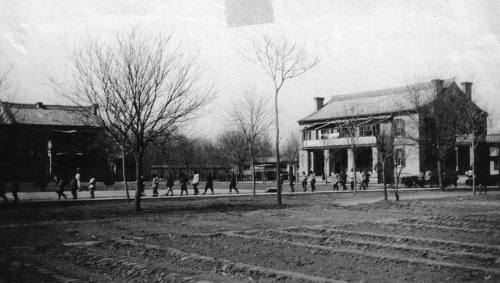
In Paotingfu The Robinsons lived in the building on the left and the building on the right housed the Galt and Hubbard families |

|
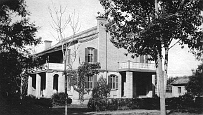
|
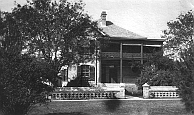
|
||
| Three different houses the Robinsons lived in during the 1920s and 1930s | ||||
|
“This was my mother’s calling card after we moved to
[Tehchow in] Shantung Province and it probably says..., I don’t
know, it doesn’t say "r’ow tie tie". That probably is
"r’ow" – our chinese name was r’ow, the last
name was r’ow, and my father’s name was "r’ow
bing shun" (like Robinson). And my oldest brother Harold’s
name was "r’ow quay min" which has a meaning and I don’t
know what it means.... And Jim was "r’ow quay duh" –
"quay" would be repeated in each time. And I was not "r’ow
quay lepai", I was "r’ow quay j’un". They’re all
biblical in some way. And this probably, it says "r’ow
something something", this would be my mother’s name but
I don’t know what it was. But this is her calling card.”
—EARR, Growing Up In China (GUiC),
Part I, March 1999
|

|
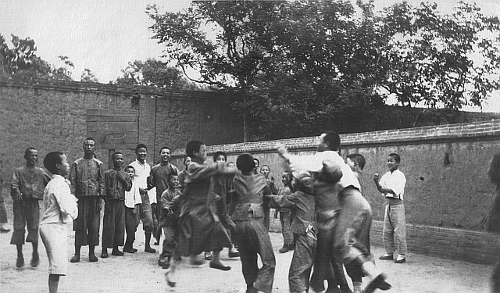
|
|
HWR’s writing on the back of this image: “A group of students on
the basket ball court at our Dartmouth School in Kao I. I played with
them after I took the picture where I was down there a few weeks ago.”
—EARR, Growing Up In China (GUiC),
Part I, March 1999
|
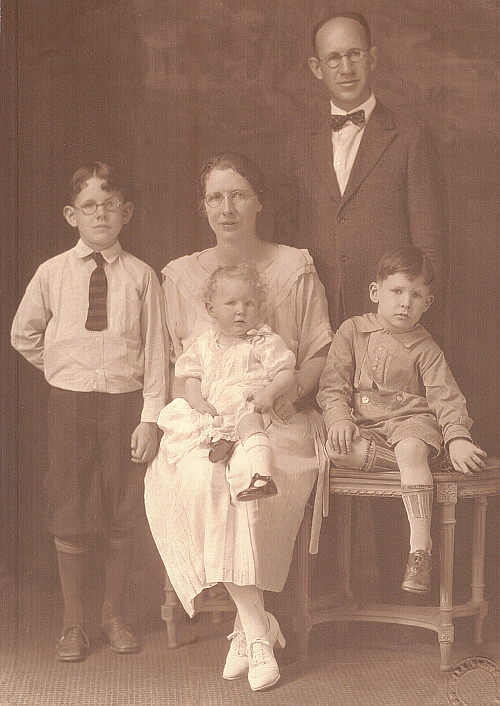
|
|
“This [is] our going-back-to-China passport picture and
everyone’s looking pretty serious.... It was a hard time
for [my mother]. We’d all been through a lot—although
I don’t remember it and I’m sure they
don’t—but, my mother had said after this seven-year
stint in China, she told Dad, your grandfather, that she would
not go back to China with him. He could go back but she
wouldn’t go—she hated it. So he said, ‘Well, I
love China but let me go and think about this. You’re my
wife and this is my family.’ And he went up and spent a
summer, or, I don’t know how long, three months or so, at
Guy and Bess’ ranch in Deer Lodge, Montana. He was a
shepherd. He took care of the sheep. My mother stayed with her
Mom in Long Beach in the little cottage that they built; it was
very cozy. But it must have been hard on my brothers. They must
have known: tension, tension, tension. And I don’t look
very happy there. When Grampa came back he said, What I really
want is to be with you and with my famiy and I’ll do
whatever you want. We’ll stay here. We’ll find
something to do here. By that time my mother had decided she
wouldn’t put him through that. And I don’t know
whether she cared anymore about China being that far away from
it, or she just thought she’d go back. So it must have been
a hard time.”
—EARR, Growing Up In China (GUiC),
Part II, March 1999
|
|
The Robinsons boarded the SS Calawaii in Los Angeles on
February, 14
1925 to return to China via Honolu. The following is Harold
Robinson’s recounting of this period culminating when he went
to Montana, from pages 79 to 81 of
Grandpa’s Story:
|
|
|
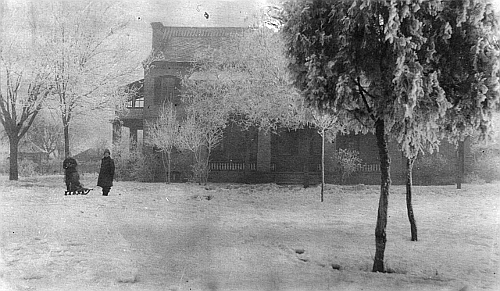
|
|
“So, we do go back to Paotingfu and here is our house and here
is the sleeping porch that I remember sleeping on...it was real cold
[in the winter] but we all had sleeping bags. And I remember that my
mother was hard—I mean she was so depressed and a difficult life
for her. I remember when I would go to bed on that sleeping porch I
would say my prayers and i would say—I made up a poem about,
I love the sleeping porch
It was comfortable. I could be cozy. And I knew that my mother
couldn’t be that way for me...[I was] five probably. Because
I do remember sitting someplace on my bed or her bed or the stairs
and realizing that there was nothing I could do to make her happy.
That’s really sad. And I think it was at that point that I
decided I had to take care of myself.”
My bed is my second mother |
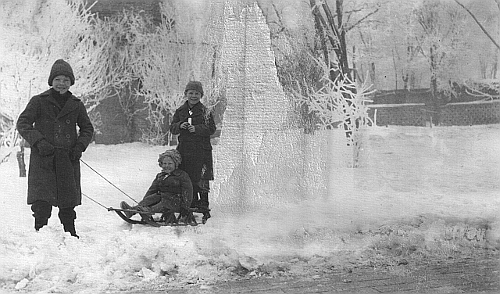
|
|
“But you can see we had snow. There’s a sled. I
don’t know what Jim is holding. The snow would melt
pretty quickly. It didn’t last very long. But it was
cold.”
|

|
|
“I think I was probably a little bit younger here with my
doll babt carriage and that little doll in it. I remember we had
these walks, thick walks. I don’t know where that was but I must
have been about three, two or three there.”
|

|
|
“And here was our crew of servants. These were very
important people in my life. This is Tien Da Tsao, this is my
amah. And she is the one, she didn’t have bound feet. And I
loved her a lot she was just wonderful. Looks as if I have a
stomach ache [laughing]. And my brother Harold [more laughter],
having a grand time! And brother Jim looking up to see what thing
Harold is going to try next. This is our wonderful Cook, "Zang
Sha Fu" [man behind Jim]. He was just great. We loved him so
much. He was very funny. I don’t know how he did it but I
remember he, somebody came by that Zang Sha Fu didn’t like
and thought he was doing—some Chinese man—and he hung
him up by his heels...he was protecting us in some way and I was
very impressed. And I know that Zang Sha Fu was the cook and when
my mother taught him how to make American breakfast (you’ve
heard this story before), by mistake she burned the toast on the
Chinese stove and she scraped it and said, ‘We don’t
throw this out—but we’re not supposed to do
this.’ But Zang Sha Fu always burned the toast and scraped
it. And this was the Gardner [behind Harold]—he was not
particularly important, he did a lot of things outside. And this
was the Table Boy [behind Elizabeth]. His name was "Bwa Lin", Bwa
Lin was our Table Boy. Zang Sha Fu was the Cook. "Shri Fu" means
Head Person. And Bwa Lin was his name. He didn’t have the
charisma that Zang Sha Fu did. He didn’t love us as much as
Zang Sha Fu did...
—EARR, Growing Up In China (GUiC),
Part II, March 1999
|
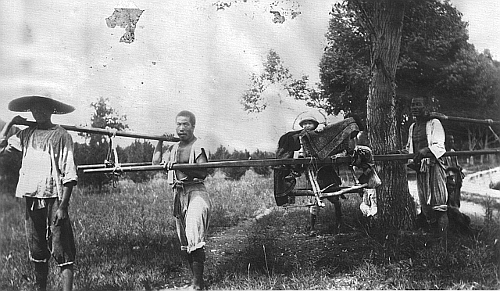
|
|
“This, I don’t know who it is. It’s probably Harold. This is
how—although I went one summer, I think, with them, to
Gwantzeling and it might have been me—this is how the
little ones went up the mountain, in a chair with bearers
carrying us.”
|

|
|
“This is in Paotingful and here’s Jim and Emma Rose and
they’re wearing Chinese padded garments, they’re very warm
coats. This is, I think...might have been Faith Galt—maybe
the Galts lived with the Hubbards for a while too. So I think
that’s Faith Galt or one of the Galts and this is me [between
Emma Rose and Faith]...Cold winter.”
|
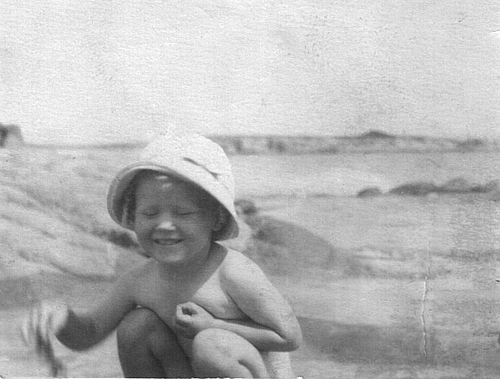
|
|
“And this, by contrast in Peitaiho, is where we went for
the summers and it’s beautiful, wonderful Pacific ocean,
down at the beach where we spent lots and lots of time. I
think I was just skinny-dipping. Loved it, it was warm and we
had total freedom there. We as foreigners had the place all to
ourselves. Chinese didn’t live there.”
|
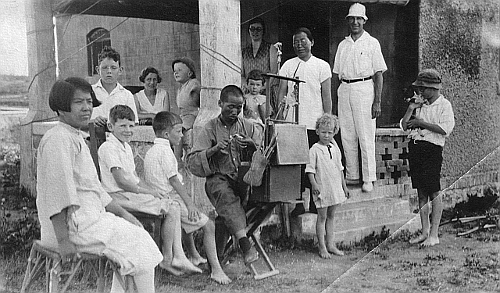
|
|
“This house was built there, and I think my folks paid for
it. Across the way was the Ballou’s house. This is Mrs. [Thelma]
Ballou [immediately to right of pillar on the porch]...The fathers
would be there only part of the summer; the mothers would be there
with their kids. This is my father [with white hat on porch], this
is my mother [second person to left of pillar], Harold looking
very sad [to the right of Mary]—Mrs. Hubbard Ballou who just
died last year. I think this is their amah [to the left of Harold],
Bobbie Ballou, Jim [in front of Harold], Larry Ballou, little me,
and this is Cristy Ballou [right of pillar]. That’s me
looking really sad. I might have...well, I don’t think that—I
think I was younger when I was punished, probably about this age,
I was punished because our amah would go with—my amah,
Tien Da Tsao, would go with me. And she was told to bring me
back for a lunch. We’d always have a big lunch in the middle of
the day and then take a nap. I didn’t want to come back. So I
bit her in the shoulder, enough to make it bleed. And she would
have clothes on. My father had just arrived from Paotingfu and
the family had been there for some time without him. He had
brought lollipops for everybody. And my punishment was, I had to
give her my lollipops. That was a punishment. And I remember
that!...I think that’s when I was about five. This looks like
when I was about two or three. But really not very happy. Maybe
I had been playing and they called me to come. [Harold Robinson
wrote on the back of the photograph:]
This was taken at Peitaiho last summer. Mrs. Ballou is standing
on the porch as is her amah. Bobby is at the left and Christy is
at the right of the porch pillar. Larry is near James and Hubbard
is holding his pup in front of the porch. Mr. [Hubbard] Ballou
took the picture. The center of attraction is the man who made all
sorts of figures out of dough and coloring matter. Some bunch when
the two families got together.
“He was a travelling guy, he walked around and carried this
on his back. And he made these wonderful figures out of flour and
water and painted them. He was very artistic. He did it for
the Chinese kids and then of course he would make more money if
he came around to the westerners. This house was where
we—this was at Lighthouse Point. And later on, because
there was just the Ballou family house over here and our
family house in Lighthouse Point and the beach was practically
empty—it was just our two families—now, the
Communists have taken it, of course—it was all foreign.
And now it’s a big place for R and R for Chinese officials,
Communist officials. And it’s changed a lot. People who have
been back don’t recognize it, saying this house is gone.
|

|
|
“This is how we got to and from the train by donkey. This was
probably—we had a dog named Casseopia. That’s probably
Casseopia.
—EARR, Growing Up In China (GUiC),
Part II, March 1999
|
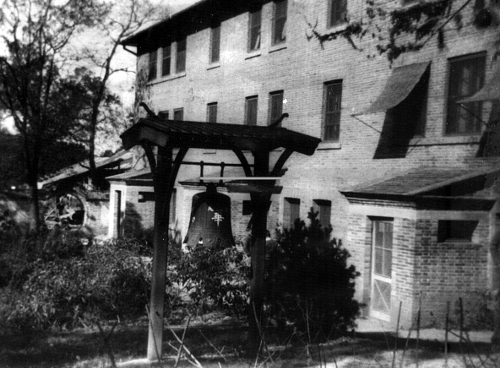
NCAS back of girl’s dormitory |
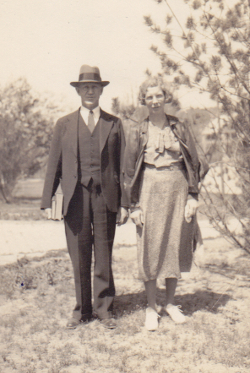
|
Harold and Mary Robinson in Tungchow, 1938
|

